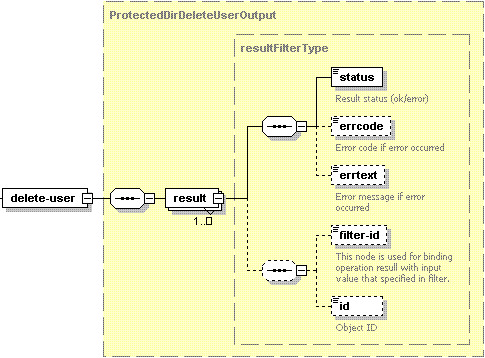Removing Protected Directory User
Use the delete-user operation to remove a protected directory user.
Request Packet Structure
A request XML packet removing a protected directory user includes the delete-user operation node:
<packet version="1.5.2.0">
<protected-dir>
<delete-user>
...
</delete-user>
</protected-dir>
</packet>
The delete-user node is presented by type
ProtectedDirDeleteUserInput (protected_dir.xsd), and its graphical
representation is as follows:

Note: The interactive schema navigator for all request packets is available here: http://plesk.github.io/api-schemas/1.6.8.0/agent_input.svg.
- The filter node is required. It specifies the filtering rule.
For details, refer to the Available Filters
section. Data type: ProtectedDirUserFilter (
protected_dir.xsd).
Response Packet Structure
The delete-user node of the output XML packet is presented by type
ProtectedDirDeleteUserOutput (protected_dir.xsd) and structured as
follows:

Note: The interactive schema navigator for all response packets is available here: http://plesk.github.io/api-schemas/1.6.8.0/agent_output.svg.
- The result node is required. It wraps the response retrieved
from the server. Data type: resultFilterType (
common.xsd). - The status node is required. It specifies the execution status of the operation. Data type: string. Allowed values: ok | error.
- The errcode node is optional. Is returns the error code if the operation fails. Data type: integer.
- The errtext node is optional. It returns the error message if the operation fails. Data type: string.
- The filter-id node is required if the request packet is valid . It returns the filtering rule parameter. For details, refer to the Available Filters section. Data type: anySimple.
- The id node is required if the operation succeeds . It returns the ID of the removed protected directory user. Data type: integer.
Samples
Removing a single protected directory user
The packet that removes the protected user with ID 12 is as follows:
<packet>
<protected-dir>
<delete-user>
<filter>
<id>12</id>
</filter>
</delete-user>
</protected-dir>
</packet>
Response:
<packet>
<protected-dir>
<delete-user>
<result>
<status>ok</status>
<filter-id>12</filter-id>
<id>12</id>
</result>
</delete-user>
</protected-dir>
</packet>
If the user was not found, the response from the server looks as follows:
<protected-dir>
<delete-user>
<result>
<status>error</status>
<errcode>1013</errcode>
<errtext>User is not found</errtext>
<filter-id>12</filter-id>
</result>
</delete-user>
</protected-dir>
Removing multiple protected directory users
The packet that removes all protected users of the directory with ID 12 is as follows:
<packet>
<protected-dir>
<delete-user>
<filter>
<pd-id>12</pd-id>
</filter>
</delete-user>
</protected-dir>
</packet>
Response:
<packet>
<protected-dir>
<delete-user>
<result>
<status>ok</status>
<filter-id>12</filter-id>
<id>1</id>
</result>
<result>
<status>ok</status>
<filter-id>12</filter-id>
<id>2</id>
</result>
</delete-user>
</protected-dir>
</packet>